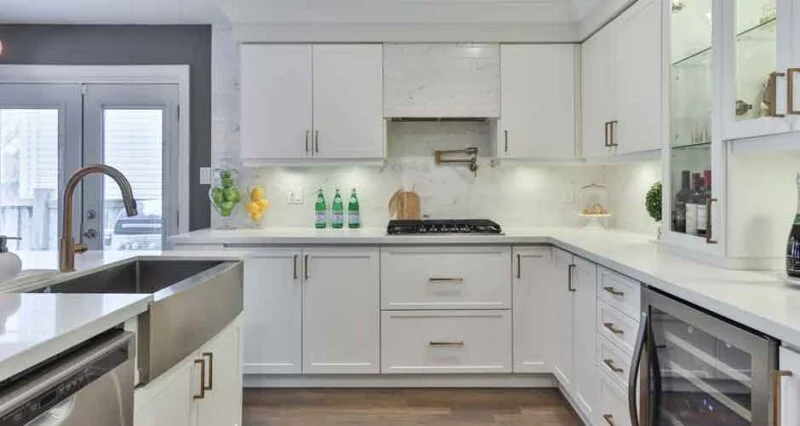
A more straightforward way to paint kitchen cabinets doesn’t require sanding or priming. It saves time and effort and gives you a beautiful, long-lasting finish. It’s an easy and efficient method to make your kitchen cabinets look great, explains GoodDoors Property Management.
Why Sanding and Priming Are Common:
In traditional painting cabinets, sanding and priming are important steps. Sanding roughs the cabinet surface so the paint sticks well to the wood.
It also helps remove old paint, smooth the surface, and prepare it for new paint.
Priming is like a base coat that seals the wood and makes it smooth for the paint. It ensures the paint sticks and prevents problems like stains and color changes.
It helps the paint look good and gives a professional finish.
Sanding and priming are done to ensure the paint sticks well, looks smooth, and the cabinets stay nice for a long time.
It’s like building a strong foundation so the paint doesn’t peel or chip, even with all the kitchen use.
Sanding and priming take time and effort, but they make a better and longer-lasting result. But there are easier ways to paint cabinets without doing all that work.
Sanding Alternatives:
There are smart ways to prepare surfaces without sanding in the world of cabinet painting. This section explores a few alternatives for homeowners seeking to transform their cabinets hassle-free.
1. Liquid Sandpaper and Deglossers
Some products, like liquid sandpaper and deglossers, offer smart ways to prepare surfaces without sanding.
These products chemically create a slightly rough surface on the cabinets, allowing the paint to grip on tight.
They also remove any shiny finishes, so your paint sticks well without a sanding session.
2. Bonding Primers: A Key to Easy Cabinet Prep
Bonding primers designed to make cabinets paint-ready without sanding. These primers create super-strong bonds between the paint and the cabinet’s surface.
That means your new paint job will last a very long time. You can choose from bonding primers, such as shellac-based or high-adhesion primers.
They all do the job well and provide a smooth base for your paint.
3. Paints with Built-in Stickiness
There are paints with built-in adhesion promoters. These paints are a real game-changer for your cabinet painting project.
They’re specially formulated to stick to all sorts of surfaces, cabinets included, and you don’t have to sand or prime them.
They contain special stuff that makes your paint hold tight, ensuring your cabinets look fantastic and last long.
These paints save you time and effort because they skip the extra preparation steps.
These alternatives are fantastic ways to prepare your cabinets for painting without the sanding fuss. They’re easier, quicker and ensure your paint sticks and looks fabulous. Now you’re all set to make your kitchen cabinets shine!
Priming Alternatives:
1. Self-Priming Paint
Let’s talk about a way to make cabinet painting easier. Self-priming paint combines two things simultaneously – a primer and paint combined.
This means you don’t have to use a separate primer before painting. Self-priming paint is designed to help the paint stick to the cabinet and last a long time.
It has special stuff that makes the paint bond well with the cabinet so it won’t peel or chip. Using self-priming paint saves homeowners time and effort, and they still get great results.
2. Stain-Blocking Primer
Sometimes, cabinets have stains or strange colors on them. To fix this, we use something called a stain-blocking primer.
It’s a barrier that seals the wood and stops stains from showing through the paint. This primer ensures the paint looks just like it should and gives cabinets a perfect look.
If there are any weird colors or stains on your cabinets, a stain-blocking primer is like a superhero that saves the day.
3.Paint with Built-In Primer
Imagine if you had paint that already had primer inside. You wouldn’t need a separate primer, which would be super easy to use.
Well, there’s paint like that! It’s specially made to stick well to cabinets without a separate primer.
This kind of paint has high-quality stuff that helps it stick to the cabinets. It’s a fantastic choice for homeowners who want to skip the priming step and save time. Using this kind of paint is like a shortcut to a great-looking finish.
Ultimately, these alternative options make priming cabinets easier and save time. They also ensure the paint sticks well, and the cabinets look fantastic.
Homeowners can confidently explore these options and get beautiful and long-lasting results in their kitchen cabinet painting projects.
Step-by-Step Guide:
For homeowners looking to paint their kitchen cabinets without the hassle of sanding and priming, here is a simplified step-by-step guide to help you achieve beautiful and long-lasting results.
Materials and Tools Required:
Before getting started, gather the following materials and tools:
- Deglosser or liquid sandpaper
- Bonding primer or self-priming paint
- High-quality paint suitable for cabinets
- Paintbrushes or rollers
- Painter’s tape
- Drop cloths or plastic sheeting
- Clean cloth or sponge
- Tack cloth (optional)
Step 1: Clean and Prep the Cabinets
Begin by thoroughly cleaning the cabinets to remove dirt, grease, or grime. Use a mild cleaner and a clean cloth or sponge to wipe down all surfaces.
Pay extra attention to areas prone to build-up, such as near the stove or sink. Once cleaned, allow the cabinets to dry completely.
Step 2: Use a Deglosser or Liquid Sandpaper
Instead of sanding, apply a deglosser or liquid sandpaper to the cabinet surfaces. Follow the manufacturer’s instructions to ensure proper application.
These products chemically etch the surface, creating a rough texture that allows the paint to adhere effectively. Wipe down the cabinets with a clean cloth or sponge after using the deglosser.
Step 3: Apply Bonding Primer or Self-Priming Paint
Next, apply a bonding primer or self-priming paint to the cabinet surfaces. These products are specially formulated to promote paint adhesion without traditional priming.
Use a paintbrush or roller to apply an even coat, following the grain of the wood. Allow the primer or self-priming paint to dry according to the manufacturer’s instructions.
Step 4: Paint the Cabinets
Once the primer or self-priming paint has dried, it’s time to paint the cabinets. Use a high-quality paint suitable for cabinets and apply it with a paintbrush or roller, again following the wood grain.
Start with the inner edges and work your way outward. Apply thin and even coats, allowing each coat to dry before adding another.
This will help prevent drips and ensure a smooth finish. Depending on the desired color and coverage, multiple coats may be necessary. Allow the final coat to dry completely.
Step 5: Clean Up and Reassemble
After the paint has dried, carefully remove any painter’s tape and clean up any drips or spills. Use a tack or clean cloth to remove any dust particles or debris from the cabinets.
Once clean, reattach the hardware and reinstall the cabinet doors and drawers. Stand back and admire your newly painted cabinets!
Homeowners can achieve professional-looking results without sanding and priming by following this step-by-step guide.
Remember to take your time and ensure each step is done thoroughly for the best outcome. Painting kitchen cabinets has always been challenging and more efficient with these alternative methods.
Tips and Techniques:
- Choose high-quality tools and paint for smooth application and flawless results.
- Take your time with preparation to ensure better adhesion and a professional finish.
- Follow the wood grain and apply thin, even coats for a seamless and consistent look.
- Consider light sanding for smoother surfaces and a polished appearance.
- Ensure proper ventilation and protect yourself from harmful particles.
- Allow each coat to fully dry before proceeding to the next step.
- Apply a protective topcoat for added durability and resistance to wear and tear.
Following these tips, homeowners can achieve a professional finish without sanding and priming, resulting in beautiful, long-lasting painted cabinets.
Pros and Cons:
Skipping sanding and priming when painting kitchen cabinets can be a good idea, but it also has some downsides. Let’s look at these methods’ good and not-so-good sides to help you decide if they’re right for your cabinet-painting project.
Advantages:
- Time-saving: These methods save lots of time because you don’t have to spend hours sanding or priming your cabinets.
- Convenient: They’re easier to use, especially if you need to improve at painting. They make the whole process simpler.
- Budget-friendly: You save money on things like sandpaper and primer by skipping the usual steps.
- Paint sticks well: Even though you’re not sanding or priming, these methods ensure the paint sticks and lasts a long time.
Disadvantages:
- Limited surface prep: They might only smooth out some bumps and scratches, especially if your cabinets are damaged.
- Less control over the look: Skipping sanding and priming means you might have less say in how your cabinets turn out, especially if they have problems.
- Fewer color choices: Some of these methods might offer fewer paint colors than regular paints, which could limit your choices.
- Only for some surfaces: You must ensure these methods work well with your cabinet material, as some surfaces need special prep for the best results.
Maintenance and Longevity:
Maintaining your painted cabinets is essential for long-lasting results.
Here are some key tips:
- Regular Cleaning: Clean your cabinets with a mild soap and soft cloth to remove dirt and grease. Avoid harsh chemicals or scrubbers that can harm the paint.
- Avoid Moisture and Heat: Protect your cabinets from excessive moisture and heat. Don’t place hot items directly on them; wipe up spills quickly to prevent damage.
- Handle with Care: Be gentle to avoid scratches or chips. Don’t slam doors or drawers and watch out for sharp objects.
- Touch-Ups: Address small chips or scratches with touch-up paint to keep your cabinets looking great. Keep some extra paint on hand and follow the manufacturer’s instructions.
Use a Protective Topcoat: Apply a protective topcoat to shield your cabinets from wear, stains, and fading. Reapply it as needed.
Regular Inspections: Check your cabinets for peeling paint, cracks, or worn areas. Fix any issues quickly to prevent further damage.
Using alternative methods for painting cabinets can help, but it’s crucial to choose high-quality products and apply them correctly. A protective topcoat and regular maintenance will extend the life of your cabinets. By following these tips, your painted cabinets will stay beautiful and enhance your space for years to come.
Cost Comparison:
When you choose a simpler way to paint your cabinets, one big benefit is that it can be more budget-friendly.
Traditional methods often need expensive sanding tools, primers, and many paint cans. On the other hand, easier methods usually require fewer materials and can save you money.
By not sanding, you can avoid buying sandpaper, sanding blocks, or renting costly sanding machines. Also, you can reduce or skip buying primer when using self-priming paints or paint with built-in adhesion promoters.
These products do the priming job, saving time and money.
Moreover, easier methods often need fewer paint coats than traditional ones. If you prepare the surface well and use good-quality paint, you can cover your cabinets with fewer coats, so you buy fewer paint cans.
Choosing a simpler way to paint your cabinets can be kinder to your wallet. You get to refresh your cabinets without spending too much.
Conclusion:
In conclusion, going for an easier method to paint your cabinets without the usual sanding and priming has many benefits. You save time, it’s convenient, it can be more cost-effective, and it makes the paint stick well.
But remember there can be downsides, like less surface prep, less control over the result, fewer color options, or possible compatibility issues. You must consider these pros and cons and pick what’s best for you.
Real-life examples show how different people have successfully used easier cabinet prep methods. Busy moms, DIY fans, and folks on a budget have all gotten great results without traditional sanding and priming.
To make your painted cabinets last, take care of them. Clean them regularly, avoid too much moisture or heat, be gentle, fix any chips, add a protective topcoat, and check them often.
To sum it up, you can confidently start your cabinet painting project by exploring simpler methods and thinking about the savings. With the right tools, good paint, and technique, you can change your cabinets and make your space beautiful. So, don’t hesitate to try the easier way and enjoy your freshly painted kitchen or any other part of your home.

